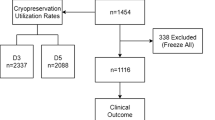Abstract
Purpose : To determine the efficiency of transferring human zygotes as opposed to human day 2 or 3 embryos.
Methods : A prospective, randomized, Multicenter trial. Patients were randomized into zygote or embryo transfer. Patients were prepared for oocyte retrieval using standardized protocols. Oocyte retrieval was performed under general anesthesia. Oocytes and spermatozoa were treated using standard laboratory techniques. All protocols were coordinated by the coordinating center.
Results : A total of 386 patients were included in the trial. Pregnancy rates were 36.5% after zygote transfer and 42% after embryo transfer. Implantation rates were equivalent (17%) in both groups.
Conclusions : No general difference was observed for zygote or embryo transfer. The results suggest that zygote transfer is a valid alternative to embryo transfer.
Similar content being viewed by others
REFERENCES
Edwards R, Steptoe PC, Purdy JM: Establishing full-term human pregnancies using cleaving embryos grown in vitro. Br J Obstet Gynaecol 1980;87:737-756
Edwards RG, Fishel SB, Cohen J, Fehilly CB, Purdy JM, Slater JM, Steptoe PC, Webster JM: Factors influencing the success of in vitro fertilisation for alleviating human infertility. J In Vitro Fertil Emb Trans 1984;1:3-23
Cummins JM, Breen TM, Harrison KL, Shaw JM, Wilson LM, Hennessey JF: A formula for scoring human embryo growth rates in in vitro fertilisation: Its value in predicting pregnancy and in comparison with visual estimates of embryo quality. J In Vitro Fertil Emb Trans 1986;4:284-295
Ahuja KK, Smith W, Tucker M, Craft I: Successful pregnancies from the transfer of pronuclear embryos in an outpatient in vitro fertilisation program. Fertil Steril 1985;44:181-184
Quinn P, Stone BA, Marrs RP: Suboptimal laboratory conditions can affect pregnancy outcome after embryo transfer on day 1 or day 2 after insemination in vitro. Fertil Steril 1990;63:168-170
Smith S, Scott L, Hosid S: Combined intrauterine triplet and ectopic pregnancy following pronuclear transfer in a patient with elevated serum progesterone during ovulation induction. J Assist Reprod Genet 1993;10:478-480
Scott LA, Smith S: The successful use of pronuclear embryo transfers the day following oocyte retrieval. Hum Reprod 1998;13:1003-1013
Dale B, Fiorentino A, De Stefano R, Di Matteo L, Wilding M, Zullo F: Activated oocyte transfer (AOT) as a stressfree approach to the treatment of infertility. Hum Reprod 1999;14:1771-1772
Tesarik J, Greco E: The probability of abnormal preimplantation development can be predicted by a single static observation on pronuclear stage morphology. Hum Reprod 1999;14:1318-1323
Tesarik J, Junca AM, Hazout A, Aubriot FX, Nathan C, Cohen-Bacrie P, Dumont-Hassan M: Embryos with high implantation potential after intracytoplasmic sperm injection can be recognised by a simple, non-invasive examination of pronuclear morphology. Hum Reprod 2000;15:1396-1399
Bavister B, Boatman D: The neglected human blastocyst revisited. Hum Reprod 1997;12:1607-1610
Gardner DK, Vella P, Lane M, Wagley L, Schlenker T, Schoolcraft WB: Culture and transfer of human blastocysts increases implantation rates and reduces the need for multiple embryo transfers. Fertil Steril 1998;69:84-88
Ludwig M, Schopper B, Al-Hasani S, Diedrich K: Clinical use of a pronuclear stage score following intracytoplasmic sperm injection: Impact on pregnancy rates under the conditions of the German embryo law. Hum Reprod 2000;15:325-329
Van Steirteghem A, Van den Abeel E: Freezing of embryos: Early vs. late stages. J Assist Reprod Genet 1993;10:185-186
Senn A, Vozzi C, Chanson A, De Grandi P, Germond M: Prospective randomized study of two cryopreservation policies avoiding embryo selection: The pronucleate stage leads to a higher cumulative delivery rate than the early cleavage stage. Fertil Steril 2000;74:946-952
Laverge H, De Setter P, Van der Elst J, Dhont MA: prospective, randomised study comparing day 2 and day 3 embryo transfer in human IVF. Hum Reprod 2001;16:476-480
Ubaldi F, Nagy Z, Rienzi L, Tesarik J, Anniballo R, Franco G, Menchini-Fabris F, Greco E: Reproductive capacity of spermatozoa from men with testicular failure HumReprod. 1999;14:2796-2800
Balaban B, Urman B, Isiklar A, Alatas C, Mercan R, Aksoy S, Nuboglu A: Blastocyst transfer following intracytoplasmic injection of ejaculated, epididymal or testicular spermatozoa Hum Reprod 2001;16:125-129
Stadtmauer L, Ditkoff E, Session D, Kelly A: High doses of gonadotropins are associated with a poor pregnancy outcome after in vitro fertilisation-embryo transfer Fertil Steril 1994;61:1058-1064
Lasken H, Ledger W, Lopez-Bernal A, Evans B: Super ovulation with a high gonadotrophin dose for in vitro fertilisation: Is it effective? J Assist Reprod Genet 1998;15:438-443
Author information
Authors and Affiliations
Rights and permissions
About this article
Cite this article
Dale, B., Fiorentino, A., de Simone, M.L. et al. Zygote Versus Embryo Transfer: A Prospective Randomized Multicenter Trial. J Assist Reprod Genet 19, 456–461 (2002). https://doi.org/10.1023/A:1020354318164
Issue Date:
DOI: https://doi.org/10.1023/A:1020354318164




